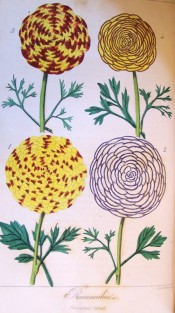Ranunculus asiaticus L.
Half-hardy, tuberous-rooted perennial buttercups with basal leaves and branching flower stems bearing 1-4 cup-shaped, red, pink, yellow or white flowers with purple-black centres in spring and summer. To 45cm. [RHSE, Hortus].
Horticultural & Botanical History
By the end of the 18th century the Florists’ ranunculus was a highly esteemed flower, being accepted as one of the original eight florists’ flowers. Thousands of named varieties were in cultivation by the 1830s in an amazing array of colours, usually very double, self-coloured or streaked, spotted and splashed with an alternate colour. A number are figured in the Floricultural Cabinet. Introduced to Britain in 1596. [JD].
History at Camden Park
Listed in all published catalogues [B.404/1843]. Ranunculus asiaticus was received per ‘Sovereign’, February 1831. [MP A2948].
Notes
Florist’s ranunculus: ‘The flower ought to be two inches in diameter; the lower tier of petals broad, and gradually diminishing in size as they approach the centre, which should be well filled up with them. The bloom ought to be of a hemispherical form; the petals not widely separated, nor too close to appear crowded, and to have a pyramidal direction, in order to display their colours; petals broad with perfect edges; colours rich, clear, and brilliant, or if of two colours, clear and distinct.’ [FC p.132/1855].
Published Jan 26, 2009 - 03:04 PM | Last updated Mar 05, 2010 - 09:31 AM
| Family | Ranunculaceae |
|---|---|
| Category | |
| Region of origin | Mediterranean, North Africa, Asia |
| Synonyms | |
| Common Name | Persian buttercup, Turban buttercup, Florists? ranunculus |
| Name in the Camden Park Record | Ranunculus Asiaticus |
| Confidence level | high |
